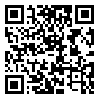Volume 2, Issue 4 (9-2015)
jbrms 2015, 2(4): 1-11 |
Back to browse issues page
Download citation:
BibTeX | RIS | EndNote | Medlars | ProCite | Reference Manager | RefWorks
Send citation to:



BibTeX | RIS | EndNote | Medlars | ProCite | Reference Manager | RefWorks
Send citation to:
Valadbeigi T, Rashki S. GC- MS analysis and anticancer effect against MCF-7 and HT-29 cell lines and antioxidant, antimicrobial and wound healing activities of plant- derived compounds. jbrms 2015; 2 (4) :1-11
URL: http://jbrms.medilam.ac.ir/article-1-186-en.html
URL: http://jbrms.medilam.ac.ir/article-1-186-en.html
Department of Biology, Faculty of Science, Ilam University, Ilam, Iran , tvaladbeigi@yahoo.com
Abstract: (7524 Views)
Introduction: Antioxidants are compounds that eliminate free radicals, which reduce tissue damage and allow the organs and blood vessels to properly heal. In this research, the anticancer effect against MCF-7 and HT-29 cell lines, and antioxidant, antimicrobial and wound healing activities of the lichens extracts have been investigated.
Materials and methods: Anticancer activity was assayed with standard MTT colorimetric procedure against MCF-7 and HT-29 cell lines. Antioxidant activity was studied by measuring DPPH, reducing power, total phenols and flavonoids assays. In vivo antimicrobial property and gas chromatography mass spectrometry analysis were evaluated.
Results: Metanolic extract of Umbilicaria decussata showed nearly 50 % HT-29 cell line inhibition at 200 μg/mL tested dose. Protoparmeliopsis muralis extract showed stronger antibacterial activity (MIC= 125 mg/mL) than Fulgensia fulgens. Also, it had a largest free radical scavenging activity (65.67%). The results revealed that there was a strong positive correlation between flavonoids and total phenolics (r= 0.952). In excision wound model, there was a significant reduction in both wound surface area and bacterial colony count in F. fulgens and especially P. muralis methanolic extracts. These significant activities are found due to the presence of unique compounds as Usnic acid, 8S,14-Cedrandiol and 3,9-Dimethyltricyclo[4.2.1.1(2,5)] dec-3-en-9-ol in P. muralis and 3-[5-(2-Chloro-5-nitro-phenyl)-furan-2-yl]-2-cyano-acrylic acid and 3-[2,4-Dichlorophenyl]-1-hydroxy-9,10-anthracenedione in F. fulgens.
Conclusion: These results show that compounds as 3-[5-(2-Chloro-5-nitro-phenyl)-furan-2-yl]-2-cyano-acrylic acid, 3-[2,4-Dichlorophenyl]-1-hydroxy-9,10-anthracenedione and usnic acid are responsible for accelerating the wound healing process by antimicrobial and antioxidant activities in these studied species.
Type of Study: Research |
Subject:
Pharmaceutics
Received: 2015/04/10 | Accepted: 2015/06/12 | Published: 2015/09/27
Received: 2015/04/10 | Accepted: 2015/06/12 | Published: 2015/09/27
Send email to the article author
| Rights and permissions | |
 |
This work is licensed under a Creative Commons Attribution-NonCommercial 4.0 International License. |




